Who Does the Groom’s Dad Walk With? Unveiling the Wedding Processional Order
Wedding planning often involves understanding various traditions and roles, especially when it comes to who walks with whom during the wedding processional. The role of the father of the groom is a distinguished one and carries certain expectations. Traditionally, the groom’s father may walk down the aisle after the groom’s mother, either alone or escorted by another family member or one of the ushers, depending on the cultural or family traditions involved. Depending on the type of wedding ceremony, these roles can vary, reflecting the diversity of wedding customs.
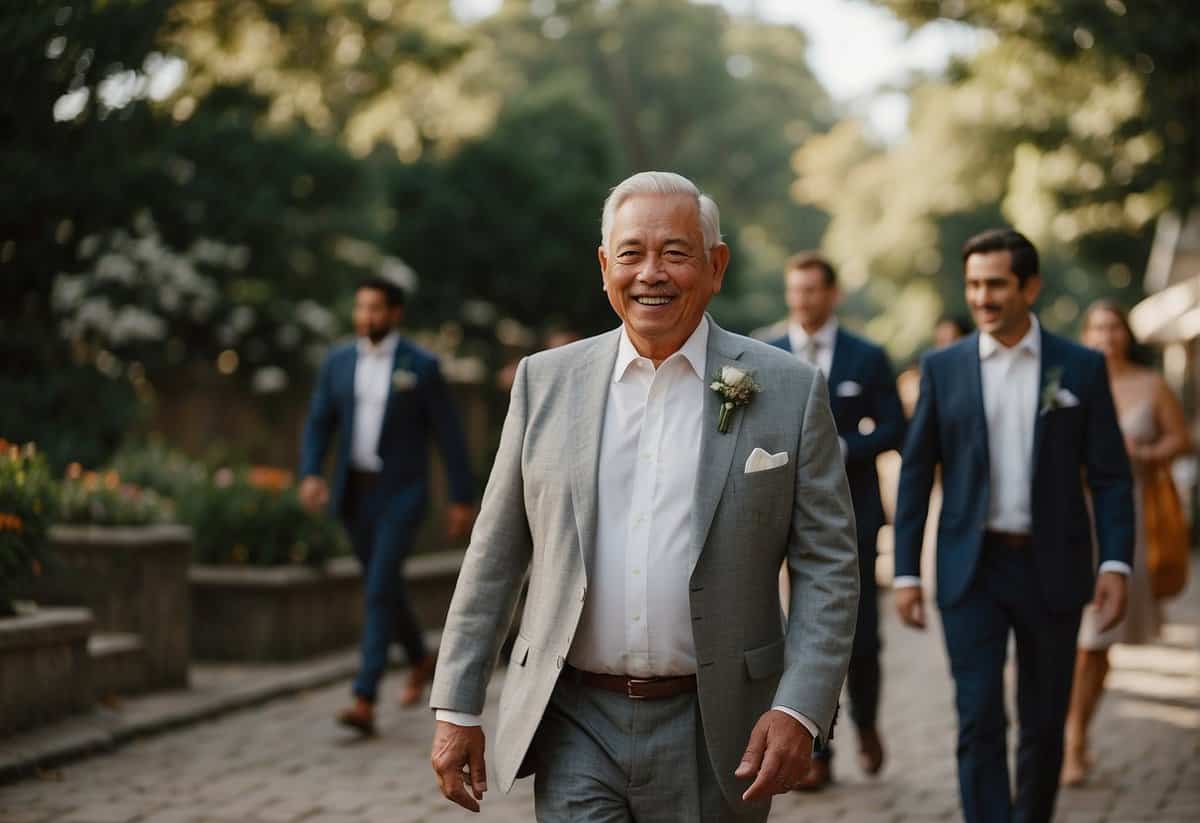
On the wedding day, the father of the groom may also serve as a pillar of support, offering both emotional and financial assistance to the groom and the family. His attire is usually chosen to complement the wedding’s theme and the groomsmen’s outfits, ensuring a cohesive look for the wedding party. As for his presentation, standing by the groom’s side, he represents a strong family presence and may engage in several pre-wedding festivities.
Key Takeaways
- The groom’s father’s role varies, depending on tradition and ceremony.
- His services extend beyond the processional, involving support for the groom.
- His attire is coordinated with the wedding party for a unified presentation.
The Role of the Groom’s Father
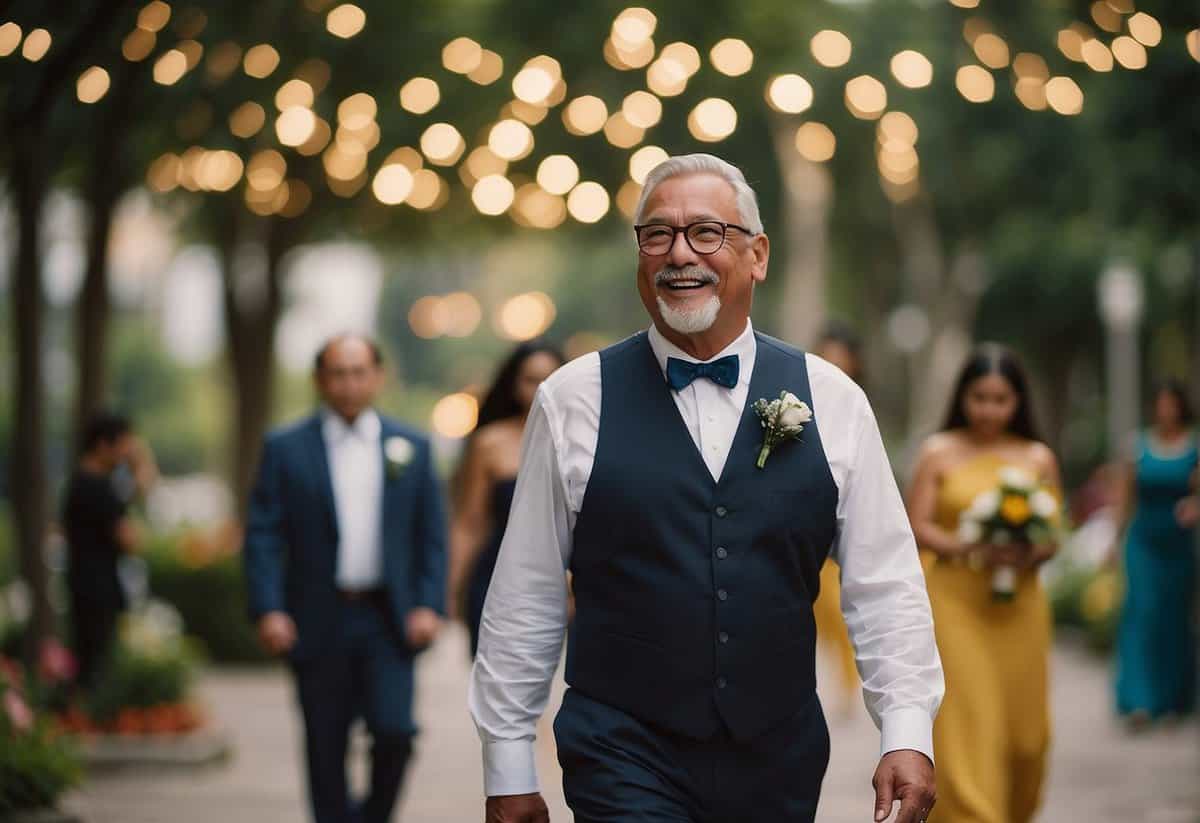
In preparing for the joyous occasion, the groom’s father has pivotal roles that range from hosting events to offering support. Your duties are not only traditional but also personalized to your family’s dynamics and the wedding’s style.
Pre-Wedding Responsibilities
Your journey as the groom’s father starts well before the wedding day. You will often offer advice and support to your son, helping with decisions that might include selecting his groom’s attire. Also, consider shouldering responsibilities such as hosting the rehearsal dinner—a perfect time to give a toast and share words of wisdom with the couple.
Ceremony Participation
As part of the wedding processional, you might walk down the aisle with the groom’s mother or another significant family member, depending on family dynamics and traditions. During the ceremony, you may also be tasked with safekeeping the wedding rings until their exchange by the bride and groom.
Reception Duties
At the reception, your role evolves to include greeting guests as part of the receiving line and ensuring that everything runs smoothly as a host. It’s also tradition for you to deliver a memorable speech or toast in honor of the newlyweds, celebrating their future together. As the day goes on, join in the joy, mingle with guests, and let your pride in your son shine.
Wedding Processional Traditions
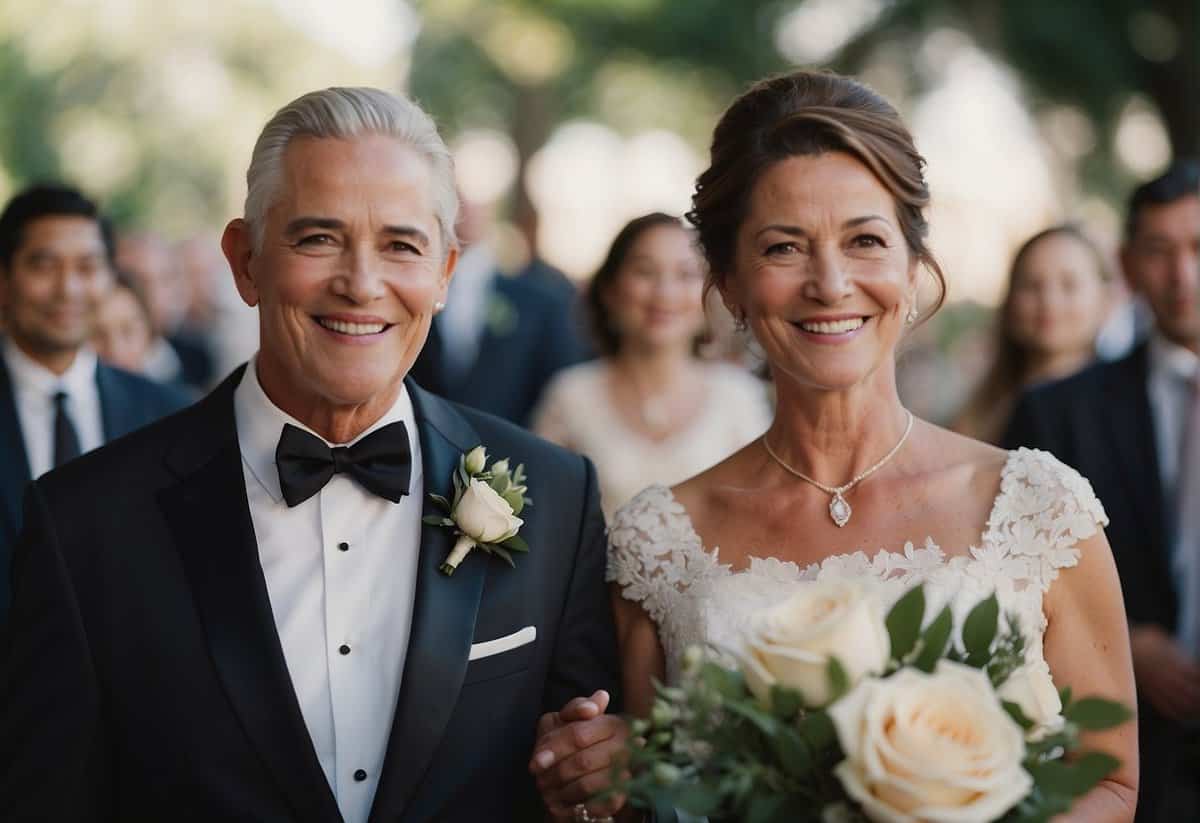
The wedding processional marks the official beginning of your nuptial ceremony, setting the tone for the event. Each culture has a specific order and tradition, which can reflect the values and history of your heritage.
Christian Wedding Order
In a Christian wedding processional, typically the groom’s parents will walk down the aisle, with the groom’s mother on the left arm of the groom’s father. This happens early in the processional, just before the bridal party makes their entrance. The officiant traditionally leads, followed by the groom, who may be alone or accompanied by his parents.
Jewish Wedding Customs
Jewish wedding customs can vary, but generally, in a traditional Jewish wedding, both sets of parents escort their child down the aisle. This symbolizes not only the union of two individuals but also the merging of two families. The groom’s parents walk with him as part of the processional, and this is often followed by the arrival of the bride, who is also typically escorted by her parents.
Hindu Wedding Processional
At a Hindu wedding, the groom’s entrance is a jubilant affair called the baraat. The groom, adorned in resplendent attire, often rides to the wedding venue on a horse, accompanied by dancing and music. Following this, the bride and groom’s families meet at the mandap, a sacred wedding altar, where they perform rituals before the processional of the bride, who may be escorted down the aisle to the mandap by her uncle or brothers.
Non-Denominational Approaches
In a nondenominational wedding, the processional order can be more flexible, allowing you to tailor it to your personal preferences and values. Typically, the groom and his parents might choose to walk down the aisle together as a reflection of their unity. Or, the groom’s father might take on another significant role depending on the couple’s wishes. The emphasis is on crafting a ceremony that feels authentic to you and your partner.
Attire and Presentation
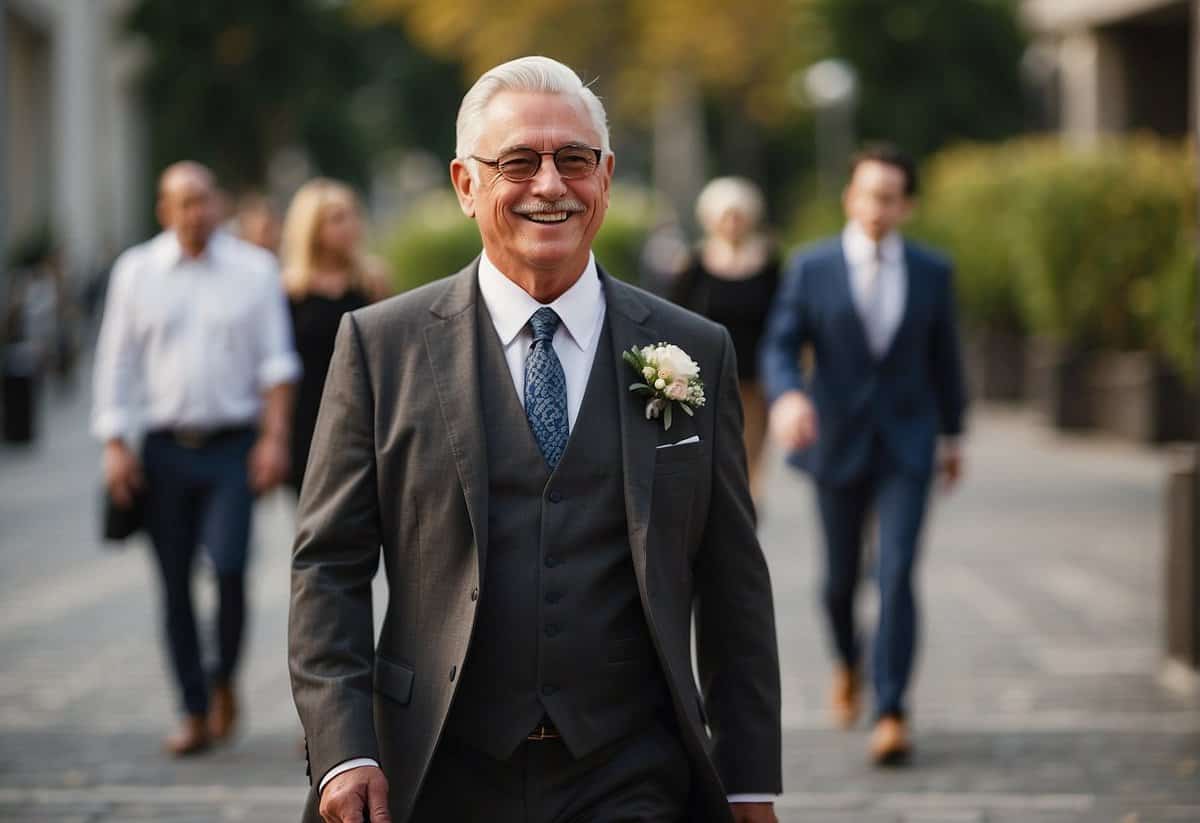
When preparing for a wedding, the father of the groom’s attire is a reflection of the wedding’s formality and style. Your ensemble should complement the wedding party, striking the right balance of elegance without overshadowing the groom.
Choosing the Right Suit
When selecting your suit, it’s crucial to consider the wedding party’s attire and the overall theme of the event. For a formal wedding, a classic black tuxedo might be your go-to. However, if the event is less formal or themed, a suit in charcoal, navy, or a lighter color could be more appropriate. Always ensure your tie matches the color scheme of the event, and don’t hesitate to ask the couple for guidance. Consider the suit’s fit too; a well-tailored suit can significantly enhance your presentation.
- Groomsmen & Best Man: Your suit should be similar but distinct from the groomsmen and best man.
- Mother of the Bride and Groom’s Mother: Coordinate with them to ensure harmonious color and style.
- Flower Girl and Ring Bearer: While not matching, your attire should harmonize with the younger participants.
Matching the Wedding Party
The wedding party, including bridesmaids, flower girls, ring bearers, and especially the groom’s attire, sets the tone for the wedding’s formality. Your attire should complement the groom’s; if he wears a bow tie, consider wearing one as well but perhaps in a different style or fabric. The dress shirt under your suit should be pristine and coordinate well with the wedding party colors.
- Tie: If the groomsmen are wearing patterned ties, choose a solid color that complements them.
- Suit: While matching is important, individuality is too—select a suit feature that subtly sets you apart.
- Grandparents: Ensure that your attire pays homage to these respected family members, perhaps through a classic and timeless look.
Financial and Planning Aspects
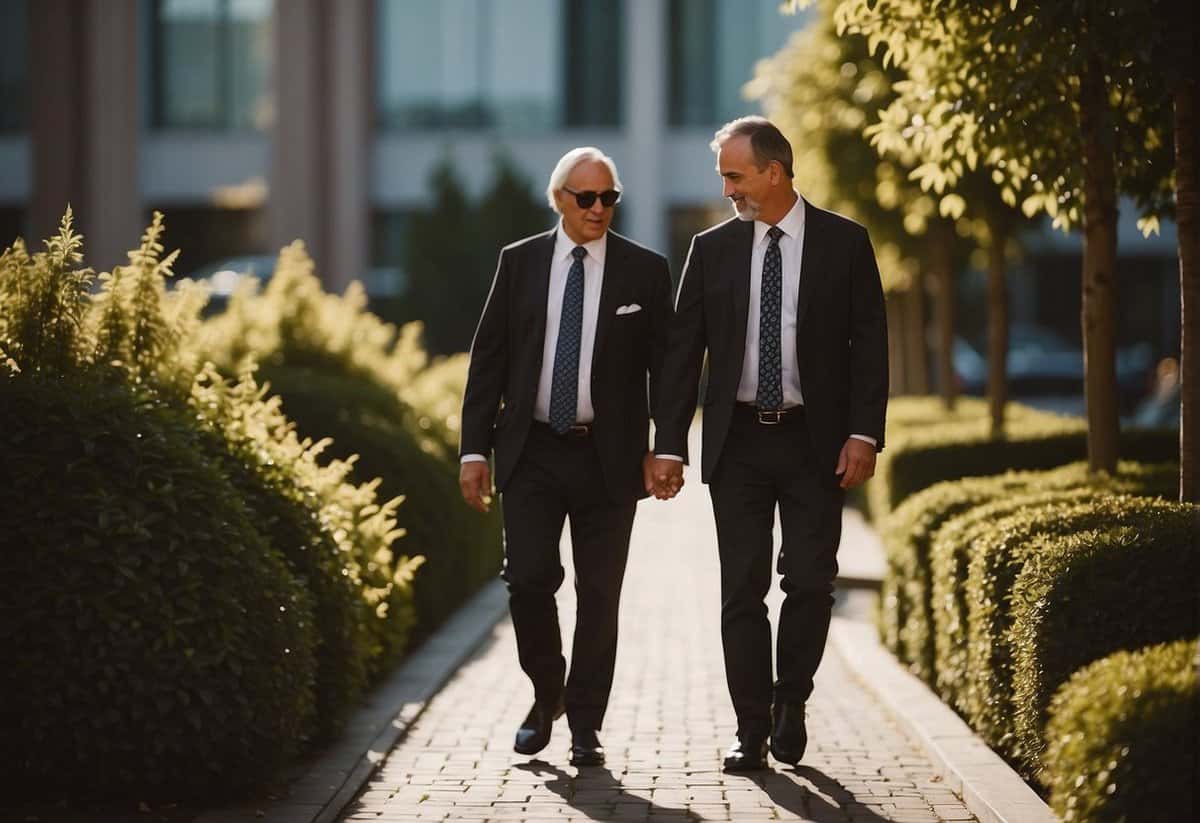
In the journey towards a memorable wedding, understanding the financial and planning aspects is essential. As the father of the groom, you’ll find your role encompasses various duties, from budgetary contributions to organizing events and shaping the guest experience.
Budget Contributions
Your financial role in the wedding planning process often hinges on traditional practices and personal agreements. You might contribute to specific aspects like the marriage license, rehearsal dinner, or even a portion of the honeymoon costs. It’s crucial to discuss the wedding budget early with the couple and other family members to clarify what expenses you are expected to cover. This can range from significant expenses like the ceremony venue to smaller yet essential details like boutonnieres for the groomsmen.
Guest List and Invitations
Your involvement in the guest list extends beyond just providing names. Collaborate with the couple to determine the overall size of the event, which will invariably impact the overall wedding costs. You’ll often have a say in selecting guests from your side of the family, ensuring those important to you are included. When it comes to invitations, you may offer support through addressing envelopes or offering insights on etiquette.
Hosting Events and Providing Support
Hosting pre-wedding events, such as the engagement party or the rehearsal dinner, typically falls under your purview. These events set the tone for the upcoming celebration and offer a chance to give financial assistance as well as logistical support. Additionally, being a pillar of support throughout the wedding planning process can take many forms, from exploring wedding ideas to assisting with DIY projects for the reception or helping select a menu that reflects the couple’s tastes. Your role is to support your new spouse and family in creating a day that honors the special union.
Frequently Asked Questions
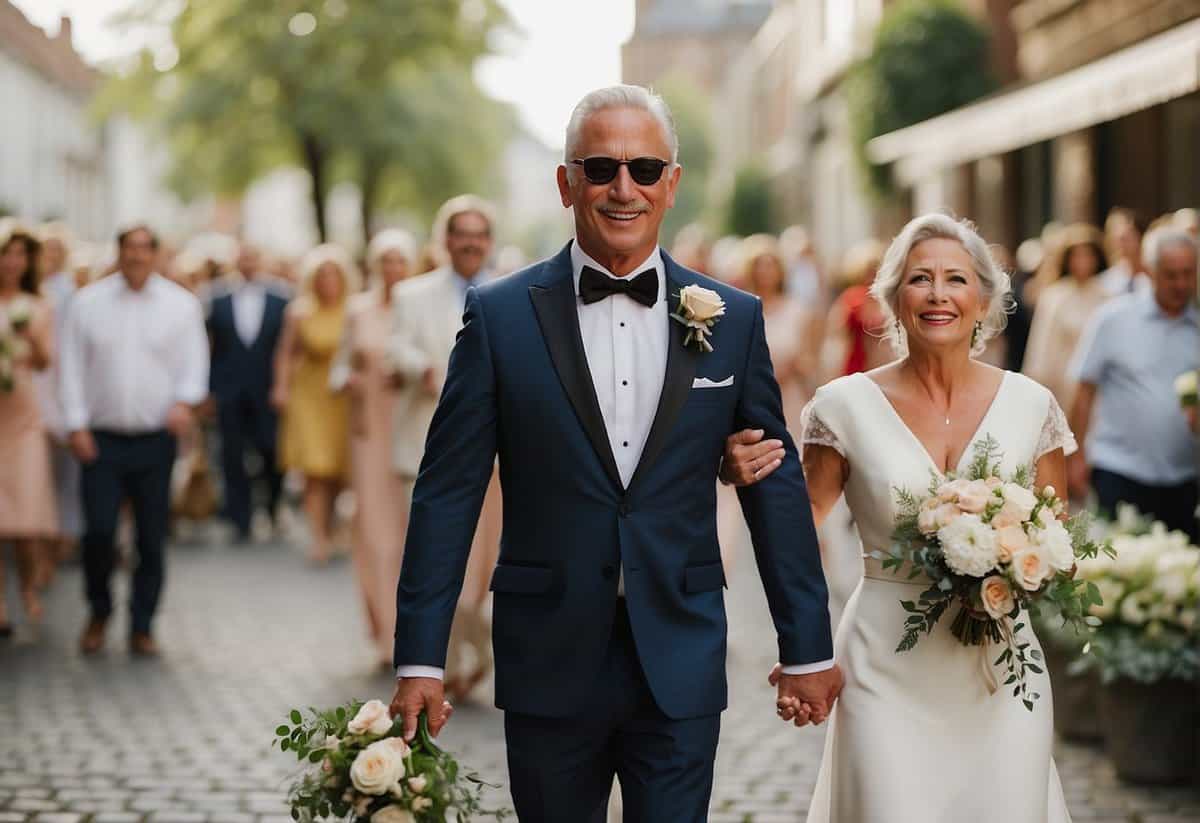
In this section, you’ll find the specifics on the father of the groom’s role during a wedding, including whom he escorts down the aisle, his attire, speech responsibilities, and more.
Who traditionally escorts the groom’s mother during the wedding processional?
Traditionally, the groom’s father escorts the groom’s mother during the wedding processional, giving them a moment of prominence and unity as they walk down the aisle together.
What is the proper attire for the father of the groom at the wedding?
The father of the groom typically wears a suit or tuxedo that complements the wedding’s attire, ensuring he matches the level of formality of the event and aligns with the groom’s side of the wedding party.
Is the father of the groom expected to give a speech at the reception?
Yes, the father of the groom is often expected to give a speech at the reception, offering well-wishes to the couple and possibly sharing a toast in their honor.
What are the typical responsibilities of the groom’s father at a wedding?
The groom’s father’s responsibilities can range from hosting the reheal dinner to contributing to wedding expenses and participating in the wedding procession and ceremonial traditions.
With whom does the groom’s father share a dance at the wedding reception?
At the wedding reception, the groom’s father usually shares a dance with the groom’s mother, creating a special moment for them and complementing the traditional mother-son dance.
What are the appropriate ways for the father of the groom to express gratitude at the wedding?
Expressing gratitude can include delivering a heartfelt speech to thank guests, personally interacting with attendees, and participating in ceremonial events that honor both families.
